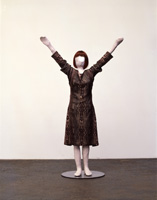
Mai-Thu Perret, Sylvania, 2006; collection of the artist; photo: Stefan Rohner; © 2008 Mai-Thu Perret
From November 21, 2008 through March 1, 2009, the San Francisco Museum of Modern Art (SFMOMA) presents New Work: Mai-Thu Perret, an exhibition of work by Swiss artist Mai-Thu Perret. Marking her first solo exhibition at a major U.S. museum, the installation will debut new sculptures created specifically for SFMOMA, along with a selection of ceramic wall-reliefs, drawings, wallpaper, and a key example of her signature papier-mâché mannequins. This focused presentation, part of the museum’s ongoing New Work series, is organized by SFMOMA Assistant Curator Apsara DiQuinzio.
Known for her multidisciplinary, installation-based practice that integrates socialist subject matter, feminist politics, and classic modernist themes, Perret reanimates issues typically associated with the 1960s and 1970s within a contemporary framework. Her invented worlds synthesize a profusion of art-historical and cultural references, as well as a range of genres—including literature, design, craft, and performance—in order to explore new utopian possibilities and establish an imaginary place that exists outside of a linear conception of time.
Perret’s work stems primarily from a fictional narrative titled The Crystal Frontier, which the artist has been writing since 1999. This ongoing, intentionally unresolved story follows a small group of women in their 20s and 30s who, in attempt to escape the impositions of capitalism and patriarchal convention, relocate to the remote desert of southwestern New Mexico and form a utopian commune called New Ponderosa Year Zero. Comprising fragmentary texts in the form of diary entries, letters, activity schedules, notebook pages, song lyrics, and newsletters written by commune members, Perret’s vivid, nonlinear narrative is used as a springboard for her art objects. These works—which include room-size installations, films, sculptures, paintings, neon signs, tapestries, ceramics, furniture, and wallpaper—draw on diverse sources, ranging from Russian avant-garde stage design to French illustration, Busby Berkeley musicals, early-20th-century mysticism, minimalism, and various other modern art movements. Rather than establishing a one-to-one correlation with the narrative, the objects are typically only alluded to in the texts (if at all) and are offered tangentially as items that could have been created by the female protagonists.
This latest installation in Perret’s continually expanding project will feature several new, large-scale sculptures on view for the first time. Made of plywood and standing more than nine feet tall, these abstract, rectilinear forms recall Robert Morris’s L-Beams from the 1960s. Drawing on the vocabulary of minimalism and postminimalism, Perret reconstitutes the forms by covering the beams variously in geometric-patterned fabric and mirrored Plexiglas. The faceted planes of the beams and their mirrored surfaces suggest crystalline shapes; the fabric she adds infuses an element of craft into these otherwise austere, modernist forms.
Also on view will be Sylvania (2006), an important example of Perret’s rough-hewn, faceless mannequins, which she forms by hand from papier-mâché. Perhaps representing an abstract surrogate for a character in The Crystal Frontier, the female figure stands with arms raised to the sky in a devotional gesture; she wears a brown, bobbed wig and a dress made by a haute-couture embroidery manufacturer in St. Gallen, Switzerland. Naturally occurring patterns of wood grain inform the textured lace motif of the dress, as do the Knot paintings of Sherrie Levine, a leading figure among an earlier generation of artists who, like Perret, work with recognizable, appropriated images.
The exhibition will also feature a new variation on one of Perret’s existing wallpaper designs, the pattern of which is modeled after an abstract fabric design of the midcentury Russian artist Varvara Stepanova. A selection of glazed, wall-mounted ceramics will also be on view. Completed in 2008, they relate to an earlier series from 2003 and incorporate motifs such as masks, hair, eggs, and other common objects. While recalling ancient symbolic forms, these fragile, craft-based objects are rooted firmly in the contemporary and typify how Perret’s work as a whole launches toward the future while simultaneously summoning the past.
In addition to Perret’s literary background (she studied literature at Cambridge University) and her research into the history of utopian communities in the United States, feminism is another important anchor of The Crystal Frontier, as the narrative is moored in the protagonists’ desire to escape a culture regulated according to patriarchal dictates. Though Perret invokes the language of classical feminism in her work—and often quotes from important female artists—its presence functions as one voice among many in her body of work. Constructivism, Marxism, theater, Bauhaus design, nature, the occult, Eastern religions, Art Nouveau, and geometric abstraction are all among the many subjects that figure into Perret’s layered, aesthetic world.
According to DiQuinzio, “Perret’s work integrates feminism into a more extended practice, ultimately taking the subject forward, spinning it in new directions. The Crystal Frontier is, in effect, an attempt to create a hopeful space of possibility, in which new subjectivities are meant to crystallize.”
Perret (b. 1976) was raised in Geneva, Switzerland, and educated at Cambridge University. She also participated in the Independent Study Program at the Whitney Museum of American Art, New York (2004). In addition to numerous group exhibitions, she had had solo exhibitions at The Kitchen, New York (2008); Kunst Halle Sankt Gallen, Switzerland (2008); Bonnefanten Museum, Maastricht (2007); The Renaissance Society at the University of Chicago (2006); and the Centre d’art contemporain, Geneva (2005).
A free illustrated brochure, with an essay by DiQuinzio, will be produced in conjunction with this presentation.
The New Work series is organized by the San Francisco Museum of Modern Art and is generously supported by Collectors Forum, the founding patron of the series. Major funding is also provided by the Mimi and Peter Haas Fund, Nancy and Steven H. Oliver, and Robin Wright. Additional support for the exhibition is provided by Pro Helvetia, Swiss Arts Council. Media support is provided by San Francisco magazine.